Books
We publish two series of proceedings and monographs, Geometry & Topology Monographs and the newer The Open Book Series™. These volumes are published free online, while printed copies are available through print-on-demand.
Books order form
You can use this books order form to produce a filled-out form that you can print and mail to us with your payment.
Book proposals
If you have a volume that would be suitable for one of our series, we’d like to hear about it. To find out more, please read about our book-publishing services.

The Open Book Series™ OA
msp.org/obs
The Open Book Series is a series of proceedings and monographs with a high quality of content. Each volume can be read freely online, while printed copies are available for purchase.

Motivic Geometry OA
Paul Arne Østvær (editor)
OBS 6 (2025) x+246
msp.org/obs/2025/6
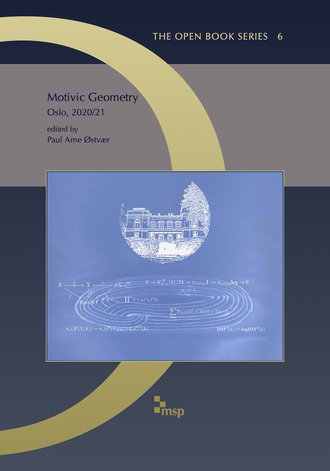
Based on lectures given at the Centre for Advanced Study (CAS) of the Norwegian Academy of Science and Letters, this book provides a panorama of developments in motivic homotopy theory and related fields.
A common goal of the research program underlying this volume is the understanding of the geometric nature of spaces, revealed through algebraic and homotopical invariants. The articles in this volume, contributed by leading experts, together touch on an extensive network of related topics in algebraic geometry, homotopy theory, K-theory and related areas.
The volume has a significant expository component, making it accessible to students, while also containing information and in-depth discussion of interest to all practitioners including specialists.
Pricing and sales

Gauge Theory and Low-Dimensional Topology: Progress and Interaction OA
John A. Baldwin, Hans U. Boden, John B. Etnyre, and Liam Watson (editors)
OBS 5 (2022) xii+332
msp.org/obs/2022/5
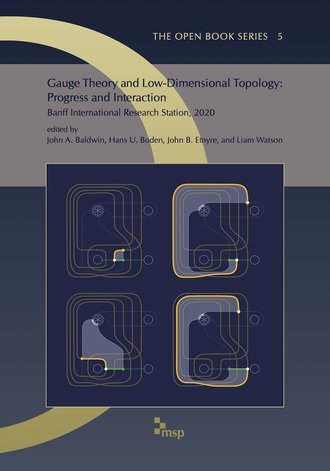
This volume is a proceedings of the sixth Banff International Research Station workshop on “Interactions of gauge theory with contact and symplectic topology in dimensions 3 and 4”, held in 2020 over the internet. The volume contains sixteen refereed papers, with an emphasis on new developments and interconnections of gauge theory, low-dimensional topology, contact and symplectic topology. It is representative of the high level of talks and results presented at the Interactions workshops over the years since its inception in 2007.
Pricing and sales

ANTS XIV: Proceedings of the Fourteenth Algorithmic Number Theory Symposium (U Auckland, 2020)
OA
Steven D. Galbraith (editor)
OBS 4 (2020) viii+422
msp.org/obs/2020/4
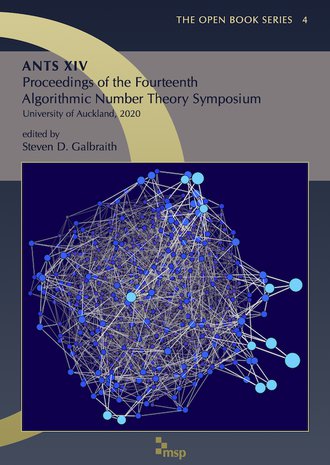
The Algorithmic Number Theory Symposium (ANTS), held biennially since 1994, is the premier international forum for research in computational and algorithmic number theory. ANTS is devoted to algorithmic aspects of number theory, including elementary, algebraic, and analytic number theory, the geometry of numbers, arithmetic algebraic geometry, the theory of finite fields, and cryptography.
This volume is the proceedings of the fourteenth ANTS meeting, which took place 29 June to 4 July 2020 via video conference, the plans for holding it at the University of Auckland, New Zealand, having been disrupted by the COVID-19 pandemic. The volume contains revised and edited versions of 24 refereed papers and one invited paper presented at the conference.
Pricing and sales

Poincaré duality in dimension 3 OA
Jonathan Hillman
OBS 3 (2020) xiv+149
msp.org/obs/2020/3
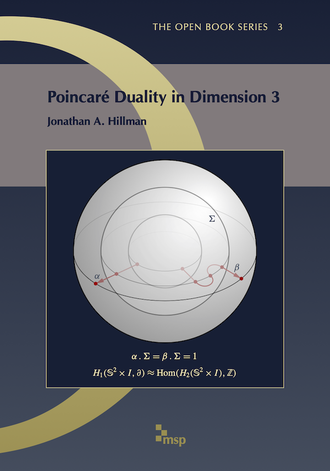
Poincaré duality is central to the understanding of manifold topology. Dimension 3 is critical in various respects, being between the known territory of surfaces and the wilderness manifest in dimensions ≥ 4. The main thrust of 3-manifold topology for the past half century has been to show that aspherical closed 3-manifolds are determined by their fundamental groups. Relatively little attention has been given to the question of which groups arise. This book is the first comprehensive account of what is known about PD3-complexes, which model the homotopy types of closed 3-manifolds, and PD3-groups, which correspond to aspherical 3-manifolds. In the first half we show that every P2-irreducible PD3-complex is a connected sum of indecomposables, which are either aspherical or have virtually free fundamental group, and largely determine the latter class. The picture is much less complete in the aspherical case. We sketch several possible aproaches for tackling the central question, whether every PD3-group is a 3-manifold group, and then explore properties of subgroups of PD3-groups, unifying many results of 3-manifold topology. We conclude with an appendix listing over 60 questions. Our general approach is to prove most assertions which are specifically about Poincaré duality in dimension 3, but otherwise to cite standard references for the major supporting results.
Target readership: Graduate students and mathematicians with an interest in low-dimensional topology.
Pricing and sales

ANTS XIII: Proceedings of the Thirteenth Algorithmic Number Theory Symposium (U Wisconsin, 2018)
OA
Renate Scheidler and
Jonathan Sorenson (editors)
OBS 2 (2018) x+478
msp.org/obs/2019/2
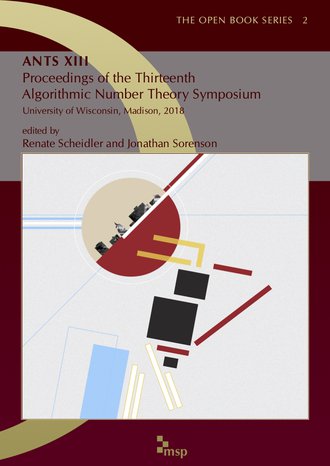
The Algorithmic Number Theory Symposium (ANTS), held biennially since 1994, is the premier inter- national forum for research in computational number theory. ANTS is devoted to algorithmic aspects of number theory, including elementary, algebraic, and analytic number theory, the geometry of numbers, arithmetic algebraic geometry, the theory of finite fields, and cryptography.
This volume is the proceedings of the thirteenth ANTS meeting, held July 16–20, 2018, at the University of Wisconsin-Madison. It includes revised and edited versions of 28 refereed papers presented at the conference.
Pricing and sales

ANTS X: Proceedings of the Tenth Algorithmic Number Theory Symposium (UC San Diego, 2012)
OA
Everett Howe and
Kiran Kedlaya (editors)
OBS 1 (2013) x+585
msp.org/obs/2013/1
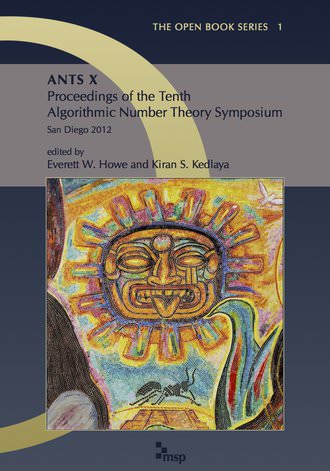
The Algorithmic Number Theory Symposium (ANTS), held biennially since 1994, is the premier international forum for research in computational number theory. ANTS is devoted to algorithmic aspects of number theory, including elementary, algebraic, and analytic number theory, the geometry of numbers, arithmetic algebraic geometry, the theory of finite fields, and cryptography.
This volume is the proceedings of the tenth ANTS meeting, held July 9–13, 2012, at the University of California, San Diego. It includes revised and edited versions of the 25 refereed papers presented at the conference, together with extended abstracts of two of the five invited talks.
Pricing and sales

Geometry & Topology Monographs OA
msp.org/gtm
The GTM series is intended for research monographs, refereed conference proceedings, and similar collections. Each volume can be read freely online, while printed copies are available for purchase.

Interactions between low-dimensional topology and mapping class groups (Max Plank, Bonn, 2013)
OA
R. Inanç Baykur, John Etnyre and
Ursula Hamenstädt (editors)
GTM 19 (2015) viii+413
msp.org/gtm/2015/19
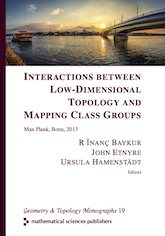
There has been a long history of rich and subtle connections between low-dimensional topology, mapping class groups and geometric group theory. From 1 to 5 July 2013, the conference “Interactions between low dimensional topology and mapping class groups,” held at the Max Planck Institute for Mathematics in Bonn, highlighted these diverse connections and fostered new and unexpected collaborations between researchers in these areas.
The proceedings for this conference aim to further draw attention to the beautiful mathematics emerging from diverse interactions between these areas. The articles collected in this volume, in addition to gathering new results, also contain expositions and surveys of the latest developments in various active areas of research at the interface of mapping class groups of surfaces and the topology and geometry of 3- and 4-dimensional manifolds. Many open problems and new directions for research are discussed.
Pricing and sales

Proceedings of the FreedmanFest (Berkeley, 2011)
OA
Rob Kirby, Vyacheslav Krushkal and
Zhenghan Wang (editors)
GTM 18 (2012) viii+450
msp.org/gtm/2012/18
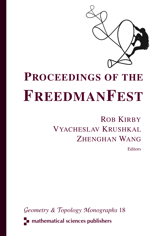
This volume is dedicated to Mike Freedman on the occasion of his 60th birthday. It contains papers on a wide variety of topics in Topology and Physics and is based on two conferences that were held in 2011. The Conference on Low-Dimensional Manifolds and High-Dimensional Categories, in honor of Michael Freedman, was held at UC Berkeley on June 6–10, 2011. It featured talks by Yakov Eliashberg, Ron Fintushel, David Gay, Cameron Gordon, Sergei Gukov, Ko Honda, Michael Hutchings, Slava Krushkal, Yanki Lekili, Scott Morrison, Frank Quinn, Martin Scharlemann, Rob Schneiderman, Catharina Stroppel, Clifford Taubes, Peter Teichner, Ben Webster, Katrin Wehrheim, and Edward Witten. The organizing committee consisted of Ian Agol, Robion Kirby, Slava Krushkal, Peter Teichner, Abigail Thompson, and Kevin Walker.
The Freedman Symposium was held at the Kavli Institute for Theoretical Physics in Santa Barbara on April 15–17, 2011. Invited lectures were given by Scott Aaronson, Sankar Das Sarma, Eddie Farhi, Matthew Fisher, Dan Freed, Matt Hastings, Charlie Kane, Alexei Kitaev, Steve Kivelson, Laci Lovasz, Andreas Ludwig, John Manferdelli, Greg Moore, Chetan Nayak, John Preskill, Xiaoliang Qi, Peter Shor, Kirill Shtengel, Steve Simon, and Xiao-Gang Wen. The conference was organized by Chetan Nayak and Zhenghan Wang.
The publication of this volume and the conferences were supported in part by Zheng-Xu He, the National Science Foundation, and Microsoft Station Q.
Pricing and sales

Lectures on Poisson geometry (Trieste, 2005)
OA
Tudor Ratiu, Alan Weinstein and
Nguyen Tien Zung (editors)
GTM 17 (2011) xiv+503
msp.org/gtm/2011/17
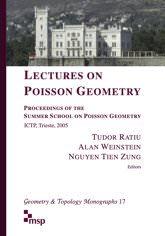
Poisson geometry is a rapidly growing subject, with many interactions and applications in areas of mathematics and physics, such as classical differential geometry, Lie theory, noncommutative geometry, integrable systems, fluid dynamics, quantum mechanics, and quantum field theory. Recognizing the role played by Poisson geometry and the significant research it has generated, the Abdus Salam International Centre for Theoretical Physics in Trieste, Italy, sponsored a 3-week summer activity on this subject (July 4–22 2005) in order to bring it to the attention of scientists and students from developing countries. There was an overwhelming response to this program, which brought together more than 150 participants from all over the world with varied backgrounds, from graduate students to experts.
The program consisted of a two-week intensive school comprising 10 minicourses, followed by a week-long international research conference. The lecturers at the school were asked to turn their notes into sections of a book that could serve as a quick introduction to the current state of research in Poisson geometry. We hope that the present volume will be useful to people who want to learn about Poisson geometry and its applications.
Pricing and sales

New topological contexts for Galois theory and algebraic geometry (Banff, 2008)
OA
Andrew Baker and
Birgit Richter (editors)
GTM 16 (2009) x+593
msp.org/gtm/2009/16
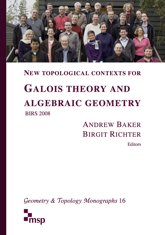
In the late twentieth century, stable homotopy theory expanded rapidly and became increasingly sophisticated in defining homotopically invariant algebraic machinery associated with multiplicative cohomology theories and their internal operations. Inputs to these developments have included established mathematical ideas from subjects such as algebraic geometry and number theory. The workshop “New Topological Contexts for Galois Theory and Algebraic Geometry” brought together topologists involved in developing or using these new techniques and allowed for the interactions with other subject areas by including non-topologist participants who would contribute to this.
Pricing and sales

Compactness and gluing theory for monopoles OA
Kim A. Frøyshov
GTM 15 (2008) viii+198
msp.org/gtm/2008/15
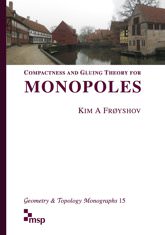
This book is devoted to the study of moduli spaces of Seiberg–Witten monopoles over spinc Riemannian 4-manifolds with long necks and/or tubular ends. The original purpose of this work was to provide analytical foundations for a certain construction of Floer homology of rational homology 3-spheres; this is carried out in “Monopole Floer homology for rational homology 3-spheres” [arXiv 0809.4842]. However, along the way the project grew, and, except for some of the transversality results, most of the theory is developed more generally than is needed for that construction. Floer homology itself is hardly touched upon in this book, and, to compensate for that, I have included another application of the analytical machinery, namely a proof of a “generalized blow-up formula” which is an important tool for computing Seiberg–Witten invariants.
The book is divided into three parts. Part 1 is almost identical to my paper “Monopoles over 4-manifolds containing long necks, I” [Geom. Topol. 9 (2005) 1–93]. The other two parts consist of previously unpublished material. Part 2 is an expository account of gluing theory including orientations. The main novelties here may be the formulation of the gluing theorem, and the approach to orientations. In Part 3 the analytical results are brought together to prove the generalized blow-up formula.
Pricing and sales

The Zieschang Gedenkschrift OA
Michel Boileau, Martin Scharlemann and
Richard Weidmann (editors)
GTM 14 (2008) xiv+567
msp.org/gtm/2008/14

This volume is dedicated to Heiner Zieschang, who has been a teacher, mentor and friend to us and to most of those that have contributed their work contained in this volume.
Contributions by: Jochen Abhau, Carl-Friedrich Bödigheimer, Anne Bauval, Semeon Bogatyi, Oleg Bogopolski, Michel Boileau, Steve Boyer, Daryl Cooper, Ralf Ehrenfried, Jan Fricke, Olga Frolkina, Claude Hayat, C. Hog-Angeloni, Donald J. Collins, André Jäger, Michael Kapovich, Akio Kawauchi, Ulrich Koschorke, Elena Kudryavtseva, Daciberg L. Gonçalves, Maria Hermínia de Paula Leite Mello, Martin Lustig, S. Matveev, Mattia Mecchia, Tomotada Ohtsuki, Luisa Paoluzzi, Joan Porti, Leonid Potyagailo, Martin R. Bridson, Robert Riley, Makoto Sakuma, Martin Scharlemann, Wilhelm Singhof, Juan Souto, Konstantin Sviridov, Satoshi Tomoda, Alina Vdovina, Ernest Vinberg, Elmar Vogt, Shicheng Wang, Richard Weidmann, Heiner Zieschang, Bruno Zimmermann, Peter Zvengrowski.
Pricing and sales

Groups, homotopy and configuration spaces (Tokyo, 2005)
OA
Norio Iwase, Toshitake Kohno, Ran Levi, Dai Tamaki and
Jie Wu (editors)
GTM 13 (2008) xii+546
msp.org/gtm/2008/13
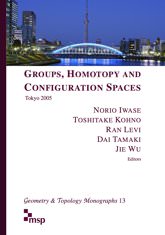
This volume is the proceedings of the conference “Groups, Homotopy and Configuration Spaces” held at the University of Tokyo, July 5–11, 2005, in honor of the 60th birthday of Fred Cohen. The emphasis of the conference was on cohomology of groups, classical and modern homotopy theory, geometry and topology of configuration spaces and related topics. However, the conference was intended to have a broad scope, with talks on a variety of topics of current interests in topology. The organizing committee consisted of Norio Iwase, Toshitake Kohno, Ran Levi, Dai Tamaki and Jie Wu. The conference was supported by the COE program of the Graduate School of Mathematical Sciences, The University of Tokyo.
Pricing and sales

Workshop on Heegaard Splittings (Technion, 2005)
OA
Cameron Gordon and
Yo'av Moriah (editors)
GTM 12 (2007) xiv+411
msp.org/gtm/2007/12
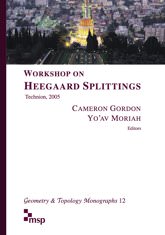
The notion of a Heegaard splitting of a 3-manifold is as old as 3-dimensional topology itself; we may recall, for example, that Poincaré described his dodecahedral space by means of a Heegaard diagram. It also seems to be the case that one of the early motivations for the study of automorphisms of surfaces was the desire to understand 3-manifolds through their Heegaard splittings. Nevertheless, for many years knowledge about Heegaard splittings was limited; the following is a more or less complete list of things that were known up to 1970: 3-manifolds are triangulable, and hence possess Heegaard splittings (Moise, 1952); any two Heegaard splittings of a given 3-manifold become isotopic afer some number of stabilizations (Reidemeister, Singer, 1933); S3 has a unique splitting of any genus up to isotopy (Waldhausen, 1968); Heegaard genus is additive under connected sum (Haken, 1968); the algebraic characterization of Heegaard splittings in terms of splitting homomorphisms (Stallings, 1966).
Starting in the 1980s, progress in the subject began to accelerate and it entered more and more into the mainstream of 3-dimensional topology, with developments coming from several different directions. There are now enough general results and techniques established to justify speaking of the theory of Heegaard splittings. A (certainly incomplete) list of recent advances in the subject is the following: the classification of Heegaard splittings of Seifert fiber spaces; the notion of strong irreducibility; the introduction of the curve complex into the study of Heegaard splittings; the use of normal and almost normal surfaces; results obtained using Cerf theory (sweep-outs); the application of the theory of minimal surfaces; geometric topological methods, including the theory of laminations; results relating Heegaard splittings to hyperbolic structures, for instance hyperbolic volume; results on the tunnel number of knots; the use of Heegaard splittings to define Heegaard–Floer homology.
It was against this background that the Technion Workshop on Heegaard Splittings was held in the summer of 2005. The goal was to gather people with a specific interest in Heegaard splittings in one workshop where the state of the art could be exposed and discussed.
It was decided by the participants to publish a proceedings of the workshop with the hope of making available to interested people a concentrated source of information about the current state of research on Heegaard splittings. Some papers were solicited from non-participants whose interests are close to the field. We wish to thank all those who contributed to this volume for their efforts.
The volume also contains a list of problems about Heegaard splittings, contributed by some of the workshop participants.
Pricing and sales

Proceedings of the School and Conference in Algebraic Topology (Hà Nôi, 2004)
OA
John Hubbuck, Nguyen H. V. Hung and
Lionel Schwartz (editors)
GTM 11 (2007) vi+441
msp.org/gtm/2007/11
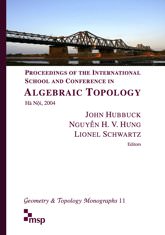
The Proceedings of the international School and Conference in Algebraic Topology, Hà Nội 2004, is a collection of articles in honour of Huỳnh Mùi, the founder of the Vietnam school in Algebraic Topology.
Not long ago, Hà Nội, the capital city, was known as the central icon of the long and terrible Vietnam War. Nowadays, Hà Nội is proud to be known as a young centre of mathematics. The international School and Conference in Algebraic Topology, Hà Nội 2004, was the first notable meeting on Algebraic Topology in Vietnam with the participation of an impressive number of both young and internationally established Algebraic Topologists.
The Hà Nội 2004 Proceedings’ main topics are the Steenrod algebra, invariant theory, classifying spaces, and group cohomology. It contains transcripts of some of the school courses and the conference talks as well as related articles submitted specifically for the Proceedings. Most of the articles in the Proceedings present original research with proofs. Others are survey articles written by leading experts.
Pricing and sales

Proceedings of the Nishida Fest (Kinosaki, 2003)
OA
Matthew Ando, Norihiko Minami, Jack Morava and
W. Stephen Wilson (editors)
GTM 10 (2007) 449
msp.org/gtm/2007/10
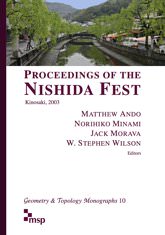
A major international meeting on homotopy theory took place in Kinosaki, Japan, from July 28–August 1 2003, followed on August 4–8 by an intense satellite conference at the Nagoya Institute of Technology. This volume contains the Proceedings of those conferences. They, and this volume, are dedicated to Professor Gôrô Nishida on the occasion of his 60th birthday.
Nishida’s earliest work grew out of the study of infinite loopspaces. His first paper (in 1968, on what came eventually to be known as the Nishida relations) accounts for interactions between Steenrod and Dyer–Lashof (Kudo–Araki) operations. This was followed by early work with H. Toda on the extended power construction, which led in 1973 to his milestone proof of the nilpotence of positive-degree elements in the stable homotopy ring of spheres.
This result, whose echoes continue to reverberate today in work of Devinatz, Hopkins, Smith, and others on the chromatic picture, and in work on motives in algebraic geometry, stood at the time as an isolated beacon of hope in the (then very mysterious) world of stable homotopy theory. It, together with the Kahn–Priddy theorem, was one of the first signs that the subject possesses deep global properties—that it held structural secrets well beyond its already formidable computational aspects. Nishida next turned his attention to a circle of ideas surrounding the Segal conjecture, transfer homomorphisms, and stable splittings of classifying spaces of groups. The ideas in this series of papers have by now grown into a rich subfield of homotopy theory, with important contributions by Benson, Feshbach, Martino, Minami, Priddy, Webb, and many others; it continues today in (for example) the theory of p-compact groups. In recent years much of his work has been concerned with various aspects of elliptic cohomology. His deep insight from the early 90s, that work of Eichler and Shimura on modular forms, higher S1-transfers, and the diffeomorphism group of the two-torus are all intimately connected, is still not adequately understood; its exploitation may depend on new geometric ideas from the developing theory of elliptic objects.
Pricing and sales

Exotic homology manifolds (Oberwolfach, 2003)
OA
Frank Quinn and
Andrew Ranicki (editors)
GTM 9 (2006) 153
msp.org/gtm/2006/09
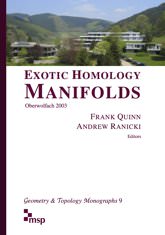
The Workshop on Exotic Homology Manifolds took place at MFO (Mathematisches Forschungsinstitut Oberwolfach) in Germany on June 29th – July 5th, 2003.
Homology manifolds were developed in the first half of the 20th century to give a precise setting for Poincaré’s ideas on duality. Major results in the second half of the century came from two different areas. Methods from the point-set tradition were used to study homology manifolds obtained by dividing genuine manifolds by families of contractible subsets. Exotic homology manifolds are ones that cannot be obtained in this way, and these have been investigated using algebraic and geometric methods. The Mini-Workshop brought together experts from both point-set and algebraic areas, along with new PhDs and experts in related areas. This was the first time this was done in a meeting focused only on homology manifolds. The 17 participants had 14 formal lectures and a problem session. There was a particular focus on the proof, 10 years ago, of the existence of exotic homology manifolds. This gave experts in each area an the opportunity to learn more about details coming from the other area. There had also been concerns about the correctness of one of the lemmas, and this was discussed in detail. One of the high points of the conference was the discovery of a short and beautiful new proof of this lemma. Extensive discussions of examples and problems have undoubtedly helped prepare for future progress in the field.
These proceedings for the meeting include an article on the history of the subject and a problem list.
There was also a wonderful interaction with the Mini-Workshop Henri Poincaré and topology, which was held in the same week. There was a joint discussion on the early history of manifolds, and both groups offered evening lectures on topics of interest to the other. Several of the daytime history lectures also drew large numbers of homology manifold participants.
Pricing and sales

The interaction of finite-type and Gromov–Witten invariants (Banff, 2003)
OA
David Auckly and
Jim Bryan (editors)
GTM 8 (2006) 456
msp.org/gtm/2006/08
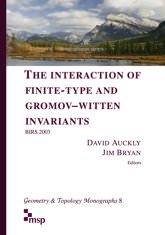
In the summer of 2001, we (Dave and Jim) were at the Gökova conference in Turkey talking about BIRS, the new mathematics institute that was going to open in Banff, Canada, in 2003. Although 2003 seemed like a long way off at the time, we wanted to propose a workshop. Fortuitously, Jim had recently heard about some exciting work in physics by Gopakumar, Vafa and others that had found some very explicit connections between topological string theory and Chern–Simons gauge theory—the very same physical theories that led to the mathematical theories of Gromov–Witten invariants and finite type invariants. Although these ideas had not yet taken hold in the math community, it seemed likely that within a few years they would be timely and warrant a workshop.
Indeed, by 2003, the topic was very timely. Physicists Aganagic, Klemm, Marino, and Vafa had developed the “topological vertex”, a gadget which (conjecturally) computed Gromov–Witten of toric Calabi–Yau threefolds in terms of certain invariants of finite type: Chern–Simons invariants. Mathematicians Li, Liu, Liu, and Zhou had begun to develop a mathematical framework for the topological vertex. Garoufalidis and Le had just proven the LMOV conjecture. This conjecture encoded integrality properties of the HOMFLY(PT) polynomial that must hold if the conjectural large-N duality was indeed true. In addition new conjectures relating large N duality with Khovanov homology were forming.
Pricing and sales

Proceedings of the Casson Fest (Arkansas and Texas, 2003)
OA
Cameron Gordon and
Yoav Rieck (editors)
GTM 7 (2004) xii+547
msp.org/gtm/2004/07
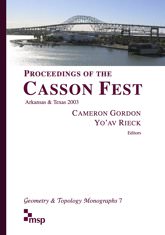
This volume contains papers on a wide range of topics in low-dimensional topology. It arose out of two events that were held in 2003. The first was the 28th University of Arkansas Spring Lecture Series in the Mathematical Sciences, which took place April 10–12, 2003. These annual conferences focus on a specific topic of current interest in mathematics, and feature a principal lecturer who gives a series of five lectures and selects additional invited speakers. In 2003 the principal lecturer was Andrew Casson, and the title of his lecture series was "The Andrews-Curtis and the Poincare Conjectures". The invited speakers were Stephen Bigelow, Martin Bridson, Danny Calegari, Nathan Dunfield, Cameron Gordon, Alan Reid, Martin Scharlemann, Zlil Sela, and Peter Shalen. A special public lecture was given by Jeff Weeks. There were also several contributed talks. The organizers were Chaim Goodman-Strauss and Yo'av Rieck. The conference was supported by NSF Grant DMS-0245047 and by the Department of Mathematical Sciences, Fulbright College of Arts and Sciences and Graduate School of the University of Arkansas.
The second event was the Conference on the Topology of Manifolds of Dimensions 3 and 4, held at the University of Texas at Austin, May 19–21, 2003, in honor of the 60th birthday of Andrew Casson. Invited lectures were given by Danny Calegari, Bob Edwards, Mike Freedman, Dave Gabai, Rob Kirby, Greg Kuperberg, Darren Long, Peter Ozsvath, Andrew Ranicki, Ron Stern, Peter Teichner, Kevin Walker, and Terry Wall. The organizing committee consisted of Cameron Gordon, Bob Gompf, John Luecke and Alan Reid. The conference was supported by NSF Grant DMS-0229035 and by the Department of Mathematics of the University of Texas at Austin.
Pricing and sales

Four-manifolds, geometries and knots OA
Jonathan Hillman
GTM 5 (2002) 382
msp.org/gtm/2002/05
The goal of this book is to characterize algebraically the closed 4-manifolds that fibre nontrivially or admit geometries in the sense of Thurston, or which are obtained by surgery on 2-knots, and to provide a reference for the topology of such manifolds and knots. The first chapter is purely algebraic. The rest of the book may be divided into three parts: general results on homotopy and surgery (Chapters 2–6), geometries and geometric decompositions (Chapters 7–13), and 2-knots (Chapters 14–18). In many cases the Euler characteristic, fundamental group and Stiefel–Whitney classes together form a complete system of invariants for the homotopy type of such manifolds, and the possible values of the invariants can be described explicitly. The strongest results are characterizations of manifolds which fibre homotopically over S1 or an aspherical surface (up to homotopy equivalence) and infrasolvmanifolds (up to homeomorphism). As a consequence 2-knots whose groups are poly–Z are determined up to Gluck reconstruction and change of orientations by their groups alone.
This book arose out of two earlier books: 2-Knots and their Groups and The Algebraic Characterization of Geometric 4-Manifolds, published by Cambridge University Press for the Australian Mathematical Society and for the London Mathematical Society, respectively. About a quarter of the present text has been taken from these books, and I thank Cambridge University Press for their permission to use this material. The arguments have been improved and the results strengthened, notably in using Bowditch’s homological criterion for virtual surface groups to streamline the results on surface bundles, using L2 methods instead of localization, completing the characterization of mapping tori, relaxing the hypotheses on torsion or on abelian normal subgroups in the fundamental group and in deriving the results on 2–knot groups from the work on 4–manifolds. The main tools used are cohomology of groups, equivariant Poincare duality and (to a lesser extent) L2–cohomology, 3–manifold theory and surgery.
The book has been revised in March 2007.
Jonathan Hillman
Pricing and sales

Invariants of knots and 3-manifolds (Kyoto, 2001)
OA
T. Ohtsuki, T. Kohno, T. Le, J. Murakami, J. Roberts and
V. Turaev (editors)
GTM 4 (2002) 572
msp.org/gtm/2002/04
The workshop and seminars on “Invariants of Knots and 3-Manifolds” took place at the Research Institute for Mathematical Sciences (RIMS), Kyoto University, in September 2001. The workshop was held over the period September 17–21. Seminars were held on the Tuesdays, Wednesdays and Thursdays of the other weeks of September, including “Goussarov day” on September 25.
Since the interaction between geometry and mathematical physics in the 1980s, many invariants of knots and 3-manifolds have been discovered and studied: polynomial invariants such as the Jones polynomial, Vassiliev invariants, the Kontsevich invariant of knots, quantum and perturbative invariants, the LMO invariant and finite type invariants of 3-manifolds. The discovery and analysis of the enormous number of these invariants yielded a new area: the study of invariants of knots and 3-manifolds (from another viewpoint, the study of the sets of knots and 3-manifolds). There are also developing topics related to other areas such as hyperbolic geometry via the volume conjecture and the theory of operator algebras via invariants arising from 6j-symbols. On the other hand, recent works have almost completed the topological reconstruction of the invariants derived from the Chern-Simons field theory.
An aim of the workshop and seminars was to discuss future directions for this area. To discuss these matters fully, we planned one month of activities, relatively longer than usual. Further, to encourage discussions among the participants, we arranged a short problem session after each talk, and requested the speaker to give his/her open problems there. Many interesting problems were presented in these problem sessions and, based on them, we had valuable discussions in and between seminars and the workshop. Open problems discussed there were edited and formed into a problem list, which, I hope, will clarify the present frontier of this area and assist readers when considering future directions.
T. Ohtsuki
Pricing and sales

Invitation to higher local fields (Münster, 1999)
OA
Ivan Fesenko and
Masato Kurihara (editors)
GTM 3 (2000) 304
msp.org/gtm/2000/03
Temporarily OUT OF PRINT.
This monograph is the result of the conference on higher local fields held in Münster, August 29 to September 5, 1999. The aim is to provide an introduction to higher local fields (more generally complete discrete valuation fields with arbitrary residue field) and render the main ideas of this theory (Part I), as well as to discuss several applications and connections to other areas (Part II). The volume grew as an extended version of talks given at the conference. The two parts are separated by a paper of K. Kato, an IHES preprint from 1980 which has never been published.
An n-dimensional local field is a complete discrete valuation field whose residue field is an (n–1)-dimensional local field; 0-dimensional local fields are just perfect (e.g., finite) fields of positive characteristic. Given an arithmetic scheme, there is a higher local field associated to a flag of subschemes on it. One of central results on higher local fields, class field theory, describes abelian extensions of an n-dimensional local field via (all in the case of finite 0-dimensional residue field; some in the case of infinite 0-dimensional residue field) closed subgroups of the n-th Milnor K-group of F.
We hope that the volume will be a useful introduction and guide to the subject. The contributions to this volume were received over the period November 1999 to August 2000 and the electronic publication date is 10 December 2000.
Ivan Fesenko and Masato Kurihara

Proceedings of the Kirbyfest (Berkeley, 1998)
OA
Joel Hass and
Martin Scharlemann (editors)
GTM 2 (1999) xvi+581
msp.org/gtm/1999/02
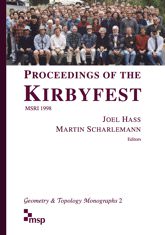
Temporarily OUT OF PRINT.
Rob Kirby’s research spans a broad spectrum of topics, all with this strong visual flavor: topological manifolds of high dimension; the structure of smooth 4-manifolds and their relationship to complex surfaces; and the emerging new invariants for both 3- and 4-dimensional manifolds. In both dimensions three and four, the “Kirby Calculus” has become a standard analytical tool. He has helped to organize and to develop problem lists which have become standard reference points for progress in geometric topology.
The Kirbyfest, held at the Mathematical Sciences Research Institute on 22–26 June 1998, attracted over 100 mathematicians from around the globe. Many of the participants were collaborators, or former students; others were just fans of Kirby and his work. There were 27 plenary talks, covering a wide variety of topologically related subjects, including several historical surveys. Fields Medalists gave five of the talks. Seven presentations were specifically organized to be easily accessible to graduate students.
We hope these proceedings convey some of the mathematical excitement of the Kirbyfest week, and we are honored to dedicate it to Rob.
